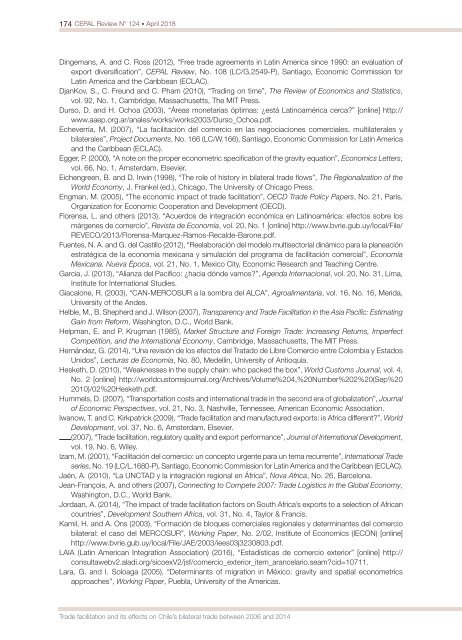CEPAL Review no. 124
April 2018
April 2018
Create successful ePaper yourself
Turn your PDF publications into a flip-book with our unique Google optimized e-Paper software.
174 <strong>CEPAL</strong> <strong>Review</strong> N° <strong>124</strong> • April 2018<br />
Dingemans, A. and C. Ross (2012), “Free trade agreements in Latin America since 1990: an evaluation of<br />
export diversification”, <strong>CEPAL</strong> <strong>Review</strong>, No. 108 (LC/G.2549-P), Santiago, Eco<strong>no</strong>mic Commission for<br />
Latin America and the Caribbean (ECLAC).<br />
DjanKov, S., C. Freund and C. Pham (2010), “Trading on time”, The <strong>Review</strong> of Eco<strong>no</strong>mics and Statistics,<br />
vol. 92, No. 1, Cambridge, Massachusetts, The MIT Press.<br />
Durso, D. and H. Ochoa (2003), “Áreas monetarias óptimas: ¿está Lati<strong>no</strong>américa cerca?” [online] http://<br />
www.aaep.org.ar/anales/works/works2003/Durso_Ochoa.pdf.<br />
Echeverría, M. (2007), “La facilitación del comercio en las negociaciones comerciales, multilaterales y<br />
bilaterales”, Project Documents, No. 166 (LC/W.166), Santiago, Eco<strong>no</strong>mic Commission for Latin America<br />
and the Caribbean (ECLAC).<br />
Egger, P. (2000), “A <strong>no</strong>te on the proper eco<strong>no</strong>metric specification of the gravity equation”, Eco<strong>no</strong>mics Letters,<br />
vol. 66, No. 1, Amsterdam, Elsevier.<br />
Eichengreen, B. and D. Irwin (1998), “The role of history in bilateral trade flows”, The Regionalization of the<br />
World Eco<strong>no</strong>my, J. Frankel (ed.), Chicago, The University of Chicago Press.<br />
Engman, M. (2005), “The eco<strong>no</strong>mic impact of trade facilitation”, OECD Trade Policy Papers, No. 21, Paris,<br />
Organization for Eco<strong>no</strong>mic Cooperation and Development (OECD).<br />
Florensa, L. and others (2013), “Acuerdos de integración económica en Lati<strong>no</strong>américa: efectos sobre los<br />
márgenes de comercio”, Revista de Eco<strong>no</strong>mía, vol. 20, No. 1 [online] http://www.bvrie.gub.uy/local/File/<br />
REVECO/2013/Florensa-Marquez-Ramos-Recalde-Barone.pdf.<br />
Fuentes, N. A. and G. del Castillo (2012), “Reelaboración del modelo multisectorial dinámico para la planeación<br />
estratégica de la eco<strong>no</strong>mía mexicana y simulación del programa de facilitación comercial”, Eco<strong>no</strong>mía<br />
Mexicana. Nueva Época, vol. 21, No. 1, Mexico City, Eco<strong>no</strong>mic Research and Teaching Centre.<br />
García, J. (2013), “Alianza del Pacifico: ¿hacia dónde vamos?”, Agenda Internacional, vol. 20, No. 31, Lima,<br />
Institute for International Studies.<br />
Giacalone, R. (2003), “CAN-MERCOSUR a la sombra del ALCA”, Agroalimentaria, vol. 16, No. 16, Merida,<br />
University of the Andes.<br />
Helble, M., B. Shepherd and J. Wilson (2007), Transparency and Trade Facilitation in the Asia Pacific: Estimating<br />
Gain from Reform, Washington, D.C., World Bank.<br />
Helpman, E. and P. Krugman (1985), Market Structure and Foreign Trade: Increasing Returns, Imperfect<br />
Competition, and the International Eco<strong>no</strong>my, Cambridge, Massachusetts, The MIT Press.<br />
Hernández, G. (2014), “Una revisión de los efectos del Tratado de Libre Comercio entre Colombia y Estados<br />
Unidos”, Lecturas de Eco<strong>no</strong>mía, No. 80, Medellin, University of Antioquia.<br />
Hesketh, D. (2010), “Weaknesses in the supply chain: who packed the box”, World Customs Journal, vol. 4,<br />
No. 2 [online] http://worldcustomsjournal.org/Archives/Volume%204,%20Number%202%20(Sep%20<br />
2010)/02%20Hesketh.pdf.<br />
Hummels, D. (2007), “Transportation costs and international trade in the second era of globalization”, Journal<br />
of Eco<strong>no</strong>mic Perspectives, vol. 21, No. 3, Nashville, Tennessee, American Eco<strong>no</strong>mic Association.<br />
Iwa<strong>no</strong>w, T. and C. Kirkpatrick (2009), “Trade facilitation and manufactured exports: is Africa different?”, World<br />
Development, vol. 37, No. 6, Amsterdam, Elsevier.<br />
(2007), “Trade facilitation, regulatory quality and export performance”, Journal of International Development,<br />
vol. 19, No. 6, Wiley.<br />
Izam, M. (2001), “Facilitación del comercio: un concepto urgente para un tema recurrente”, International Trade<br />
series, No. 19 (LC/L.1680-P), Santiago, Eco<strong>no</strong>mic Commission for Latin America and the Caribbean (ECLAC).<br />
Jaén, A. (2010), “La UNCTAD y la integración regional en África”, Nova Africa, No. 26, Barcelona.<br />
Jean-François, A. and others (2007), Connecting to Compete 2007: Trade Logistics in the Global Eco<strong>no</strong>my,<br />
Washington, D.C., World Bank.<br />
Jordaan, A. (2014), “The impact of trade facilitation factors on South Africa’s exports to a selection of African<br />
countries”, Development Southern Africa, vol. 31, No. 4, Taylor & Francis.<br />
Kamil, H. and A. Ons (2003), “Formación de bloques comerciales regionales y determinantes del comercio<br />
bilateral: el caso del MERCOSUR”, Working Paper, No. 2/02, Institute of Eco<strong>no</strong>mics (IECON) [online]<br />
http://www.bvrie.gub.uy/local/File/JAE/2003/iees03j3230803.pdf.<br />
LAIA (Latin American Integration Association) (2016), “Estadísticas de comercio exterior” [online] http://<br />
consultawebv2.aladi.org/sicoexV2/jsf/comercio_exterior_item_arancelario.seam?cid=10711.<br />
Lara, G. and I. Soloaga (2005), “Determinants of migration in México: gravity and spatial eco<strong>no</strong>metrics<br />
approaches”, Working Paper, Puebla, University of the Americas.<br />
Trade facilitation and its effects on Chile’s bilateral trade between 2006 and 2014


















